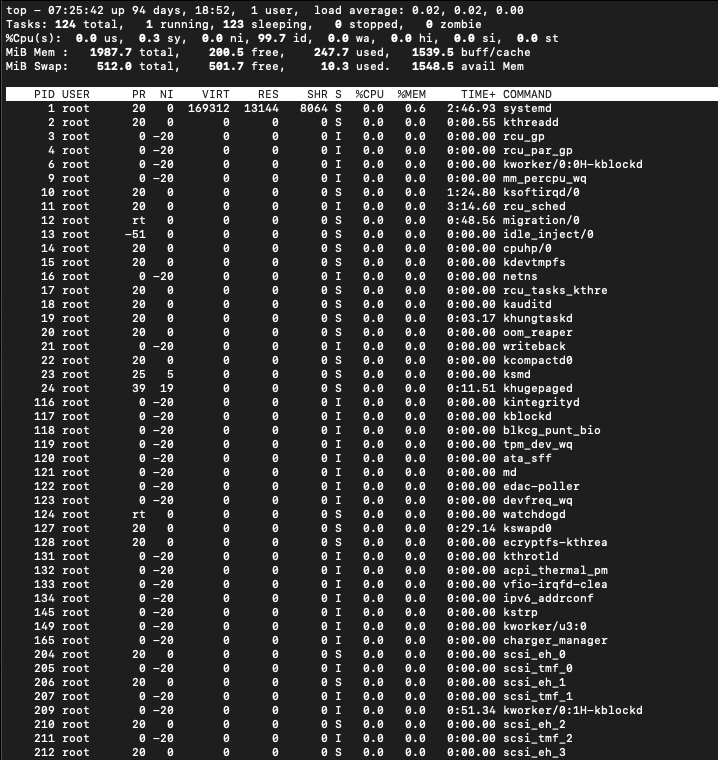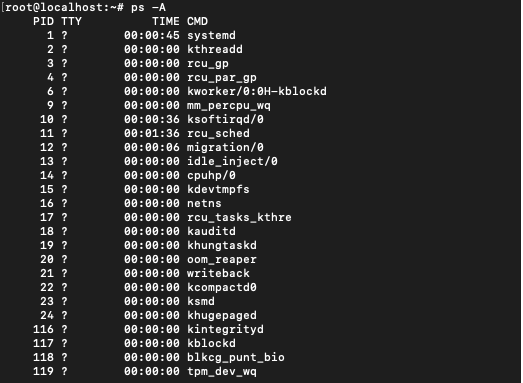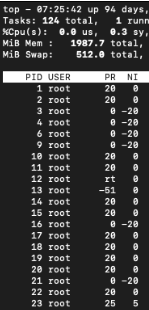Linuxにおけるプロセス管理のコマンド
この記事では、Linuxにおけるプロセス管理について説明します。Linuxにおけるプロセスとは、実行中のプログラムのことです。プログラムの実行中のインスタンスです。実行する任意のコマンドはプロセスを開始します。
Linuxにおけるプロセスの種類
Linuxにおいて、プロセスは2つのタイプに分けられます。
- Foreground Processes
depend on the user for input
also referred to as interactive processes - Background Processes
run independently of the user
referred to as non-interactive or automatic processes
Linuxにおけるプロセスの状態
Linuxにおけるプロセスは、作成された後、終了する前にさまざまな状態を経ることがあります。これらの状態は次の通りです。
- Running
- SleepingInterruptible sleep
Uninterruptible sleep - Stopped
- Zombie
- A process in running state means that it is running or it’s ready to run.
- The process is in a sleeping state when it is waiting for a resource to be available.
- A process in Interruptible sleep will wakeup to handle signals, whereas a process in Uninterruptible sleep will not.
- A process enters a stopped state when it receives a stop signal.
- Zombie state is when a process is dead but the entry for the process is still present in the table.
Linuxのプロセス管理における異なるコマンド
Linuxで実行中のプロセスを追跡するためには、2つのコマンドが利用可能です。これらのコマンドは「Top」と「Ps」です。
1. Linuxプロセスを管理するためのトップコマンド
マシン上で実行中のプロセスを追跡するには、topコマンドを使用することができます。
$ top

Topコマンドは、実行中のプロセスのリストをリアルタイムで表示し、それぞれのメモリとCPU使用率も表示します。出力内容をより理解しましょう。
- PID: Unique Process ID given to each process.
- User: Username of the process owner.
- PR: Priority given to a process while scheduling.
- NI: ‘nice’ value of a process.
- VIRT: Amount of virtual memory used by a process.
- RES: Amount of physical memory used by a process.
- SHR: Amount of memory shared with other processes.
- S: state of the process‘D’ = uninterruptible sleep
‘R’ = running
‘S’ = sleeping
‘T’ = traced or stopped
‘Z’ = zombie - %CPU: Percentage of CPU used by the process.
- %MEM; Percentage of RAM used by the process.
- TIME+: Total CPU time consumed by the process.
- Command: Command used to activate the process.
リストを上下にナビゲートするために上下の矢印キーを使用できます。終了するには「q」を押してください。プロセスを終了するには、上下の矢印キーでプロセスを選択し、「k」を押してください。
後で見ることができる「killコマンド」を使用することもできます。
2. psコマンド → psコマンド
psコマンドは、『プロセス状態』の略称で、現在実行中のプロセスを表示します。ただし、topコマンドとは異なり、生成される出力はリアルタイムではありません。
$ ps

用語は次のようになります:
| PID | process ID |
| TTY | terminal type |
| TIME | total time the process has been running |
| CMD | name of the command that launches the process |
psコマンドを使用してさらに情報を取得する。
$ ps -u

ここに: (Koko ni)
- %CPU represents the amount of computing power the process is taking.
- %MEM represents the amount of memory the process is taking up.
- STAT represents process state.
psコマンドは現在実行中のプロセスのみを表示しますが、すべてのプロセスをリストするためにも使用することができます。
$ ps -A

現在実行されていないプロセスを含めて、このコマンドはすべてのプロセスをリストアップします。
3. プロセスを停止する (Purosesu wo teishi suru)
Linuxでプロセスを停止するには、’kill’コマンドを使用します。killコマンドはプロセスにシグナルを送信します。
異なる種類のシグナルを送信することができます。しかし、最も一般的なものは「kill -9」であり、それは「SIGKILL」と呼ばれています。
次のようにして、すべての信号をリスト表示することができます。
$ kill -L

デフォルトのシグナルは15であり、それはSIGTERMです。つまり、番号を指定せずに単にkillコマンドを使用すると、SIGTERMシグナルが送信されます。
プロセスを終了するための構文は以下の通りです:
$ kill [pid]
代わりに、あなたはまた次のようにも使用することができます:
$ kill -9 [pid]
このコマンドはプロセスに「SIGKILL」シグナルを送信します。通常のキル要求を無視する場合に使用するべきです。
4. プロセスの優先度を変更する
Linuxでは、プロセス間の優先順位を設定することができます。プロセスの優先度値は「ニース(Niceness)」値と呼ばれます。ニース値は-20から19までの範囲で指定されます。デフォルトの値は0です。
topコマンドの出力の4番目の列は、niceness値の列です。

デフォルト以外の値でプロセスを開始するには、次のように使用します。 (Deforuto igai no kachi de purosesu o kaishi suru ni wa, tsugi no yō ni shiyō shimasu.)
$ nice -n [value] [process name]
既に実行中のプロセスの優先度を変更するには、次の方法を使用します。
renice [value] -p 'PID'
結論は、
このチュートリアルでは、Linuxのプロセス管理について説明しました。主に、プロセス管理の実践的な側面に焦点を当てました。理論的には、プロセス管理は広範なトピックであり、完全にカバーすることはこのチュートリアルの範囲外です。

